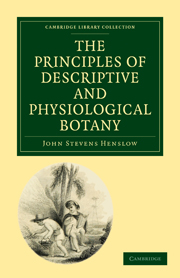Book contents
- Frontmatter
- Contents
- INTRODUCTION
- PART I DESCRIPTIVE BOTANY
- SECTION I ORGANOGRAPHY AND GLOSSOLOGY
- SECTION II TAXONOMY AND PHYTOGRAPHY
- PART II PHYSIOLOGICAL BOTANY
- CHAPTER I VITAL PROPERTIES AND STIMULANTS
- CHAPTER II FUNCTION OF NUTRITION — Periods 1, 2, 3, 4
- CHAPTER III FUNCTION OF NUTRITION — continued — Periods 5, 6
- CHAPTER IV FUNCTION OF NUTRITION — continued — Period 7
- CHAPTER V FUNCTION OF REPRODUCTION — Periods 1, 2, 3
- CHAPTER VI FUNCTION OF REPRODUCTION — continued — Periods 4, 5
- CHAPTER VII EPIRRHEOLOGY, BOTANICAL GEOGRAPHY, FOSSIL BOTANY
- INDEX AND GLOSSARY
CHAPTER VII - EPIRRHEOLOGY, BOTANICAL GEOGRAPHY, FOSSIL BOTANY
Published online by Cambridge University Press: 05 December 2011
- Frontmatter
- Contents
- INTRODUCTION
- PART I DESCRIPTIVE BOTANY
- SECTION I ORGANOGRAPHY AND GLOSSOLOGY
- SECTION II TAXONOMY AND PHYTOGRAPHY
- PART II PHYSIOLOGICAL BOTANY
- CHAPTER I VITAL PROPERTIES AND STIMULANTS
- CHAPTER II FUNCTION OF NUTRITION — Periods 1, 2, 3, 4
- CHAPTER III FUNCTION OF NUTRITION — continued — Periods 5, 6
- CHAPTER IV FUNCTION OF NUTRITION — continued — Period 7
- CHAPTER V FUNCTION OF REPRODUCTION — Periods 1, 2, 3
- CHAPTER VI FUNCTION OF REPRODUCTION — continued — Periods 4, 5
- CHAPTER VII EPIRRHEOLOGY, BOTANICAL GEOGRAPHY, FOSSIL BOTANY
- INDEX AND GLOSSARY
Summary
(298.) Epirrheology. — This term has recently been proposed, to express that branch of our science which treats of the effects produced by external agents upon the living plant. It can only be considered as a subordinate department of vegetable physiology, and one indeed whose limits are not very strictly defined. For we have seen that life itself requires the stimulus of external agency, in order that its powers may be elicited, and produce the various phenomena of vegetation included under one or other of the two functions of nutrition and reproduction. But then these functions become variously modified, according as the external stimuli by which they are called into action are permitted to operate with greater or less intensity. In all cases, there is that happy mean which can so regulate the vital force as to produce a healthy and vigorous condition of existence; whilst every increase or diminution in the stimulus applied, only tends to injure or greatly to modify the individual subjected to its long-continued influence. Physiology might be considered as embracing the investigation only of such phenomena as resulted from the healthy condition of the vital functions; whilst epirrheology would take further cognisance of such as resulted from an unhealthy condition of vegetation. Hence this department would lay the foundations of another branch, termed the “nosology” of plants, or that science which treats of their diseases; and also of the extensive subject of “Botanical Geography,” which makes inquiry into those causes which limit the distribution of various species to certain spots upon the earth's surface.
- Type
- Chapter
- Information
- The Principles of Descriptive and Physiological Botany , pp. 290 - 314Publisher: Cambridge University PressPrint publication year: 2009First published in: 1835



